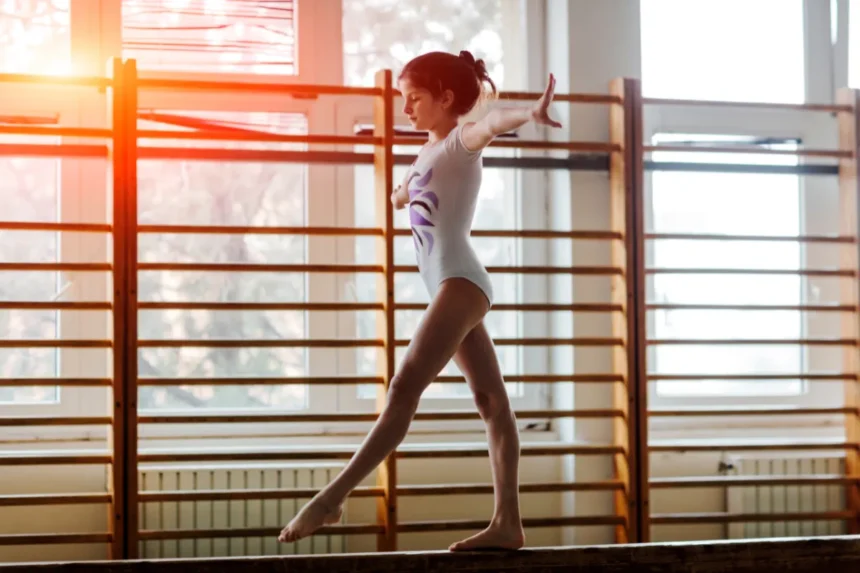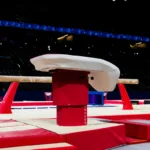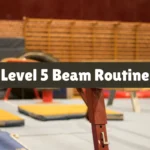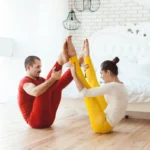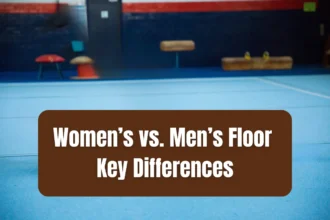The balance beam is often seen as the ultimate test of a gymnast’s balance, precision, and artistry. With its narrow surface and high demands, it requires gymnasts to combine strength, flexibility, and control while performing complex acrobatic and dance elements.
In this guide, we’ll walk through the beam skill requirements for Levels 1 through 5, highlighting the key elements gymnasts need to master at each stage.
Level 1 Beam Skill Requirements
At Level 1, gymnasts are introduced to the basic elements of balance, flexibility, and form on the beam. The emphasis is on learning fundamental skills with proper technique and control.
Key Skills:
- Beam Mount: Gymnasts start by learning simple mounts like the step-up mount, which involves stepping onto the beam and standing with feet together. This skill teaches basic balance and body control.
- Straight Leg Hold: A foundational skill where gymnasts hold one leg straight in front of them while balancing on the beam. This demonstrates balance and flexibility.
- Pike Jump: Gymnasts perform a jump with legs straight and together, bending at the hips to create a pike position in the air. This skill tests flexibility, body control, and timing.
- Forward and Backward Rolls: These rolls teach gymnasts how to move fluidly across the beam while maintaining balance and control.
- Basic Dismount: The gymnast dismounts from the beam with a simple dismount, typically a jump or a simple step down.
Routine Structure:
The Level 1 beam routine focuses on basic movements with an emphasis on form and control. The routine should demonstrate smooth transitions between the skills, but speed and complexity are secondary to balance and precision.
➡️ Recommended Level 1 Beam Routine
Level 2 Beam Skill Requirements
At Level 2, gymnasts begin to increase the complexity of their skills, adding more dynamic elements like jumps and basic acro skills while continuing to focus on form.
Key Skills:
- Beam Mount (Tuck Jump): Gymnasts now learn the tuck jump mount, which involves jumping onto the beam from a standing position, bringing the knees to the chest and landing in a balanced position.
- Splits: Gymnasts perform split jumps and straddle splits on the beam. These movements require flexibility, control, and height during the jump.
- Forward Walkover: This is a beginner acro skill where the gymnast performs a backbend and pushes through into a standing position. It tests flexibility and strength.
- Arabesque: A balancing skill where the gymnast lifts one leg behind them while maintaining a straight body position. This skill requires balance and core strength.
- Basic Dismount: The gymnast performs a simple dismount, usually a jump or a step-down from the beam, with emphasis on form and control.
Routine Structure:
Level 2 routines become slightly more complex, introducing splits, walkovers, and jumps. Gymnasts must still focus on their balance, but they begin to develop more dynamic elements and transitions.
➡️ Recommended Level 2 Beam Routine
Level 3 Beam Skill Requirements
At Level 3, gymnasts are expected to demonstrate better fluidity in their routines and incorporate more advanced acrobatic elements, such as walkovers and basic turns.
Key Skills:
- Beam Mount (Jump to Front Support): Gymnasts perform a jump to front support (with the body in a straddle or tucked position), focusing on balance and smooth transition.
- Backward Roll to Stand: Gymnasts perform a backward roll on the beam and end up standing. This skill adds a level of coordination and control, requiring the gymnast to maintain balance throughout.
- Back Walkover: A key acro skill at Level 3, the back walkover involves starting from a standing position and performing a controlled backbend into a handstand-like position before stepping out with the feet. It tests flexibility, balance, and strength.
- Pivot Turns: The gymnast performs a pivot turn (a 180-degree or 360-degree rotation on one foot), demonstrating control, footwork, and balance.
- Dismount (Jump with 180-degree Split): Gymnasts are required to perform a jump with a 180-degree split during the dismount. This skill combines flexibility and power.
Routine Structure:
Level 3 routines introduce acro elements like the back walkover, requiring gymnasts to perform more complex movements with better control and fluidity. The transitions between the skills should be smooth, and gymnasts must begin to show artistry in their performance.
➡️ Recommended Level 3 Beam Routine
Level 4 Beam Skill Requirements
At Level 4, gymnasts are expected to demonstrate more advanced skills and greater difficulty in their routines, with a focus on acrobatic sequences and more challenging balance poses.
Key Skills:
- Beam Mount (Back Handspring or Front Handspring): Gymnasts perform more dynamic mounts, including a back handspring mount or front handspring mount to start the routine with greater power.
- Back Walkover Series: Gymnasts perform multiple back walkovers within the routine, requiring fluidity, strength, and flexibility.
- Handstand: The gymnast must perform a handstand on the beam, holding the position briefly before returning to the beam. This skill demonstrates balance, strength, and control.
- Leap with 180-degree Split: A jump with a full split in the air, showing flexibility and height. This is a key element in Level 4 routines to demonstrate dynamic jumping skills.
- Dismount (Round-off Back Handspring or Back Tuck): Gymnasts now perform a more advanced dismount, often involving a round-off back handspring or back tuck to demonstrate strength, flexibility, and control.
Routine Structure:
Level 4 routines are more dynamic and complex, with gymnasts required to combine acro elements like back walkovers and back handsprings. The routine should demonstrate fluidity, strength, and artistry, with an emphasis on power and precision.
➡️ Recommended Level 4 Beam Routine
Level 5 Beam Skill Requirements
At Level 5, gymnasts are expected to perform highly complex and dynamic acrobatic skills, with an increased focus on artistry and individual expression. This is the highest level in the compulsory gymnastics program, where gymnasts prepare for optional routines.
Key Skills:
- Beam Mount (Acro Elements): Gymnasts perform acrobatic mounts such as a back handspring mount or back tuck mount, starting the routine with high-level skill and precision.
- Series of Acro Skills (Back Walkover, Back Handspring, Layout): Gymnasts are expected to link multiple acro skills in a fluid series, demonstrating strength, balance, and coordination.
- Handstand (with 180-degree Turn): The gymnast performs a handstand with a 180-degree turn on the beam, adding a challenging rotation element.
- Switch Leap or Split Leap with 180-degree Split: The gymnast must perform switch leaps or split leaps, showing height, flexibility, and control.
- Dismount (Double Back Handspring or Back Tuck): The dismount at this level involves advanced tumbling passes, like double back handsprings or a back tuck, demonstrating power and control.
Routine Structure:
Level 5 routines are the most complex, combining multiple acro elements with highly skilled dismounts. Gymnasts must perform with precision, strength, artistry, and dynamic movement. Routines are faster-paced and more dynamic, with gymnasts expected to demonstrate their full range of skills and artistic expression.
➡️ Recommended Level 5 Beam Routine
| Skill | Level 1 | Level 2 | Level 3 | Level 4 | Level 5 |
|---|---|---|---|---|---|
| Beam Mount | Step-up mount | Tuck jump mount | Jump to front support | Back handspring mount | Acrobatic mount |
| Balance Hold | Straight leg hold | Split balance | Arabesque balance | Handstand | Handstand with turn |
| Acro Skills (Rolls) | Forward and backward rolls | Forward and backward rolls | Back walkover | Back walkover series | Back handspring series |
| Jump (Split) | Pike jump | Split jump | Split leap | 180° split jump | 180° split jump |
| Turn | Pivot turn | 180° turn | 360° turn | ||
| Dismount | Simple jump or step-down | Simple jump or step-down | Jump with 180° split | Round-off back handspring | Back tuck or back handspring series |
Key Observations:
- Level 1 focuses on basic mount, balance, rolls, and simple jumps.
- Level 2 adds more dynamic mounts, split jumps, and introduces the back walkover.
- Level 3 incorporates acro skills like back walkovers, pivot turns, and higher jumps.
- Level 4 introduces the back handspring series, handstands, and advanced jumping skills.
- Level 5 requires complex dismounts and acrobatic sequences, setting the foundation for optional routines.
From Level 1 to Level 5, gymnasts gradually build upon basic skills, developing more complex acrobatic elements and mastering higher levels of precision and control.
Source: USA Gymnastics
